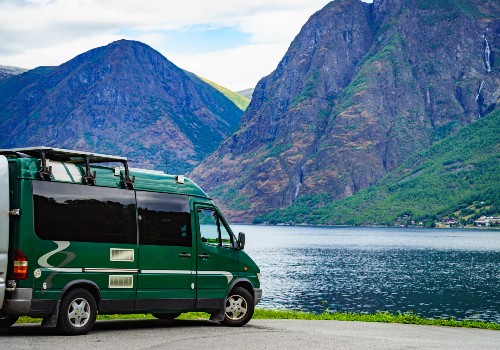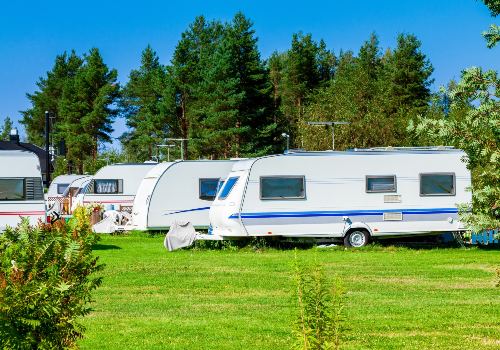Camping in U.S national parks go together like peanut butter and jelly. Our national lands are on every RVers bucket list as soon as they catch the desire to purchase one. Yet some of today’s RVs can’t get past the entrance gates because they exceed the best RV lengths for national parks.
The longest RVs allowed in national parks are between 25-30 feet in total length.
We’ll explore the many reasons for this limit and why it’s not always true. You’ll learn the best strategy to land that most sought after campsite at the best national parks for RV camping and how to get the best deal. Our research led us to a controversial proposed modernization plan to update the national park campgrounds that’s worth discussion.
RV Measurements Further Explained

National park spaces range in size between 20-40 feet. Some parks have 30 feet spaces with a couple of 40 feet spaces. As you can imagine those “prime real estate” campsites fill up quickly. Mostly, you’ll run across 30-foot spaces.
When they say 30 feet, they mean it. If you have a motorhome, a class C or small class A won’t be much of a problem. If you’re toading your passenger car, that’s where it becomes difficult. Your total length, including anything your towing must be 30 feet or less. There won’t be a place for your passenger car and the park rangers can deny your entrance.
Towable trailers have a similar problem. The average car, truck, and SUV measures between 14-17 feet. This means that the size trailer you need for national parks must be 16 feet or less from hitch to bumper. Small travel trailers, pop-ups, and teardrops are your best bet.
The majority of sites are primitive sites (no hookups). Most have a handful of spaces with either electric-only or water and electric. Full hookup sites do exist in certain national parks but they fill up fast.
The public parks usually have bathhouses that they maintain well but don’t expect a camp store, rental equipment shack on-site, or other amenities. Most either no longer allow campfires or have heavy restrictions on them. Whatever supplies you may need, pick them up ahead of time because the nearest store is going to be many miles away.
Road conditions are usually dirt. Smaller parks may have tight turns and other road conditions that make it very difficult for large motorhomes, fifth wheels, and travel trailers to navigate. It’s a safe assumption that back-in sites are going to be par for the course.
Current Conditions of Most U.S. National Parks

Most people think that our national parks started with the Antiquities Act of 1906, signed by President Theodore Roosevelt in his second term. Actually, in 1832, President Andrew Jackson signed a bill into law protecting land in Arkansas from private development.
President Woodrow Wilson created the National Park Service in 1916. This new bureau established the actual parks on federally protected land, gave it funding, and employed staff. The first camping craze of the roaring 1920s led the Park Service to establish campgrounds in many of the parks.
One of the major destinations for World War II veterans were national parks. Many new parks established during this second camping bubble had campgrounds added into the plans for the “Canned Ham” era RVs. With President Eisenhower’s new interstate highway system, the parks were affordable and easy to get too.
The point is, many of these campgrounds opened during time periods when RVs were smaller and less technologically advanced than the ones we have today. Those that have plumbed in campground utilities can’t update the campsites without destroying protected land.
Older campgrounds within the parks have lost space due to the growth of the natural plant life. The staff maintains the campgrounds through lawn care and other normal tasks, but cutbacks and preservation guidelines allow the skeleton crew to do so much.
Best Way to Make a Reservation
If you’re planning an RV national park road trip to see as many as possible, be strategic. The summer months when children are out of school is the busiest time for both state and national parks. The spring and fall are going to be the best times to find open campsites.
If your coach isn’t the best RV size for the public park, there are many private campgrounds surrounding the park. They have to compete with the park and the other private parks in the area, so you can expect them to have modern accommodations with full hookups, long campsites, and additional features.
Park Finder Website
If your goal is to stay at the park itself, a great strategy is to take advantage of both the website and to call them directly. The National Park Service’s Park Finder Website lists all of the U.S. parks, help you narrow down your search based on a number of different criteria, and connects you to their specific pages.
Once you know the details about the park and what length RV will fit in a parking space, call the ranger station directly. The campgrounds operate on either reservation only or first-come-first-serve (FCFS) depending on how busy and the time of year. The ranger can also tell you what campsites available based on cancelations or those that have left early.
America the Beautiful Annual Pass

A great money saver is the National Park Service’s America the Beautiful Annual Pass. Campground fees generally range between $30-$50 a night. The annual pass allows you entrance into the parks free of charge and other features that they charge per person.
A one-time charge of $80 will give the pass holder and up to 3 passengers in a private, non-commercial vehicle use of the pass benefits to all of the national parks and other public lands that are open to the general citizenry. Children 15 and younger are free of charge and don’t count under the three passenger limit.
Active military personnel can receive their pass free of charge. We thank you for your commitment to our country and thank you for your service.
There are three ways you can buy your pass. Either on-site at one of the national parks, over the phone, or through the USGS Store. The website allows you to printout a temporary pass until you receive your permanent pass via U.S. Mail.
Access Pass
Seniors (62 and older) and the disabled can apply for another type of pass. The Access Pass gives the additional benefit of a 50% discount on primitive campsites. Renewal is $20 a year.
What it Would Take to Modernize
What if national parks update their campgrounds? They could install every campsite with full hookups and wifi. Camp stores and restaurants would be available on-site. What if the national parks have RV size limits increased to 45 feet and the roads remade to accommodate RVs of those sizes?
There are modernization proposals floating around Washington D.C. that talk about doing this. Proponents and opponents are debating the protection of the ecological versus the economical advantages to the national parks.
The more famous parks like Yellowstone, Grand Canyon, and Yosemite are still popular. Yet some of the lesser-known parks that offer incredible landscapes and outdoor excitement are suffering from revenue losses. Overall visitation is slowly declining.
National Parks Are Still Worth the Trip
Taking your RV out to any one of our national parks can be a trip of a lifetime. You’ll see unique landscapes that only exist here in our country. The United States has the most diverse geographies on the planet. In our nation, you can climb mountains, journey through deserts, swim in oceans, and hike on glaciers.
This is the purpose of our national parks. Grab your family, pack up your RV and go explore.
- Experience the depth of the Grand Canyon National Park
- Debate who has the biggest nose on Mount Rushmore National Memorial Park
- Set your watch to Old Faithul at Yellowstone National Park
- Explore the wonders underground in Mammouth Cave National Park
- Walk the same field the Confederates did at Gettysburg National Military Park
- Take a boat tour in the deepest lake at Crater Lake National Park




